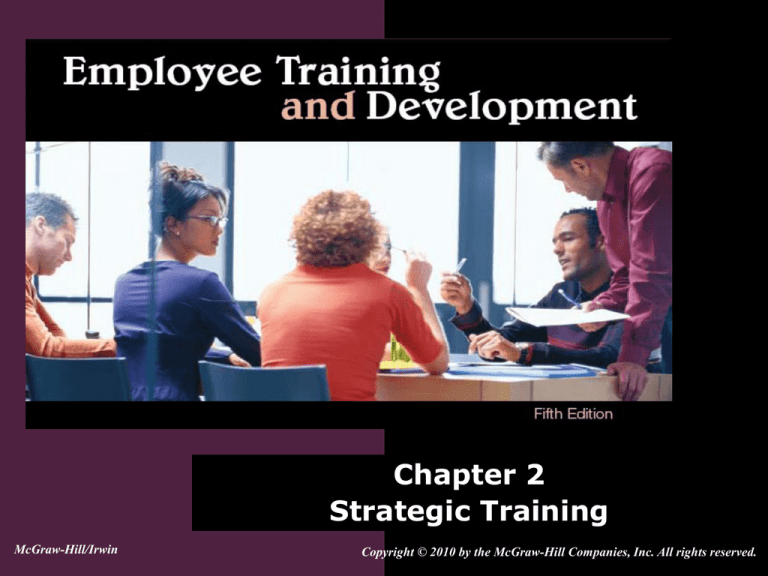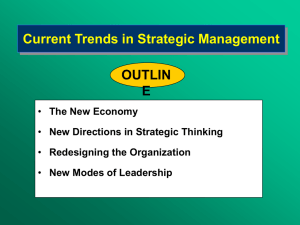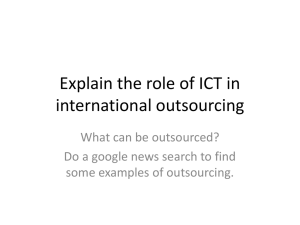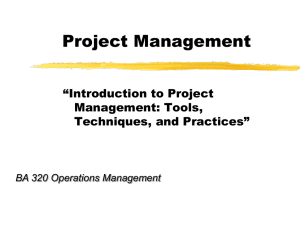
Chapter 2
Strategic Training
McGraw-Hill/Irwin
Copyright © 2010 by the McGraw-Hill Companies, Inc. All rights reserved.
Introduction
Business strategy – a plan that
integrates the company's goals, policies,
and actions.
The strategy influences how the company
uses:
physical capital, financial capital, and human
capital.
Goals – what the company hopes to
achieve in the medium- and long-term
future.
2-2
Introduction (cont.)
Strategy has a particularly strong
influence on determining:
The amount of training devoted to current or
future job skills.
The extent to which training is customized for
the particular needs of an employee or is
developed based on the needs of a team,
unit, or division.
Whether training is restricted to specific
groups of employees or open to all
employees.
2-3
Introduction (cont.)
Strategy has a particularly strong
influence on determining:
Whether training is planned and
systematically administered, provided only
when problems occur, or developed
spontaneously as a reaction to what
competitors are doing.
The importance placed on training compared
to other human resource management
practices such as selection and compensation.
2-4
Figure 2.1 - Evolution of
Training's Role
2-5
The Evolution of Training’s Role
Learning – the acquisition of knowledge
by individual employees or groups of
employees who are willing to apply that
knowledge in their jobs in making
decisions and accomplishing tasks for the
company.
Knowledge – what individuals or teams
of employees know as well as company
rules, processes, tools, and routines.
It is either tacit knowledge or explicit
knowledge.
2-6
The Evolution of Training’s Role
(cont.)
Explicit knowledge – knowledge that
can be formalized, codified, and
communicated.
Tacit knowledge – personal knowledge
based on individual experience that is
difficult to explain to others.
2-7
The Evolution of Training’s Role
(cont.)
Key capabilities needed to implement
learning strategies:
Alignment of learning goals to the business
goals.
Measurement of the overall business impact
of the learning function.
Movement of learning outside the company to
include customers, vendors, and suppliers.
A focus on developing competencies for the
most critical jobs.
2-8
The Evolution of Training’s Role
(cont.)
Key capabilities needed to implement
learning strategies:
Integration of learning with other human
resource functions such as knowledge
management, performance support, and
talent management.
Training delivery approaches that include
classroom as well as e-learning.
Design and delivery of leadership
development courses.
2-9
Figure 2.2 - The Strategic Training
and Development Process
2-10
The Strategic Training and
Development Process
Mission – the company's reason for existing.
Vision – the picture of the future that the
company wants to achieve.
Values – what the company stands for.
SWOT analysis – an analysis of the company's
operating environment to identify opportunities
and threats as well as an internal analysis of the
company's strengths and weaknesses.
The company has to consider its competition.
2-11
The Strategic Training and
Development Process (cont.)
Strategic training and development
initiatives – learning-related actions
that a company should take to help it
achieve its business strategy.
2-12
Table 2.2 - Strategic Training and
Development Initiatives and Their Implications
2-13
Table 2.3 - Questions to Ask to Develop
Strategic Training and Development Initiatives
2-14
The Strategic Training and
Development Process (cont.)
Metrics are used to identify:
trainees' satisfaction with the training
program.
whether the trainees' knowledge, skill, ability,
or attitudes changed as a result of program
participation.
whether the program resulted in businessrelated outcomes for the company.
2-15
The Strategic Training and
Development Process (cont.)
Balance scorecard – means of
performance measurement that provides
managers with a chance to look at the
overall company performance or the
performance of departments or functions
It considers four perspectives: customer,
internal, innovation and learning, and
financial.
2-16
Table 2.6 - The Roles and Duties of Managers in
Companies That Use High-Performance Work
Practices
2-17
Organizational Characteristics
That Influence Training
Top management support
The CEO is responsible for vision, and being a
sponsor governor, faculty, learner, and
marketing agent.
The degree to which a company's units or
businesses are integrated affects the kind
of training that takes place.
Global presence.
Business conditions.
2-18
Organizational Characteristics
That Influence Training (cont.)
Human resource management (HRM)
practices – the management activities
related to investments, staffing
performance management, training, and
compensation and benefits.
2-19
Organizational Characteristics
That Influence Training (cont.)
Staffing strategy – the company's
decisions regarding where to find
employees, how to select them, and the
desired mix of employee skills and
statuses.
Human resource planning –
identification, analysis, forecasting, and
planning of changes needed in the human
resource area to help the company meet
changing business conditions.
2-20
Figure 2.4 - Implications of
Staffing Strategy for Training
2-21
Organizational Characteristics
That Influence Training (cont.)
Extent of unionization
Unions' interest in training has resulted in
joint union-management programs designed
to help employees prepare for new jobs.
Staff involvement in training and
development
If managers are not involved in the training
process, training may be unrelated to
business needs.
2-22
Organizational Characteristics
That Influence Training (cont.)
Staff involvement in training and
development
If line managers are aware of what
development activity can achieve, they will be
more willing to become involved in it.
They will also become more involved in the training
process if they are rewarded for participating.
An emerging trend is that companies expect
employees to initiate the training process.
2-23
Table 2.7 - Implications of
Business Strategy for Training
2-24
Table 2.7 - Implications of
Business Strategy for Training
2-25
Table 2.7 - Implications of
Business Strategy for Training
2-26
Models of Organizing the Training
Department
Centralized training - training and
development programs, resources, and
professionals are primarily housed in one
location and decisions about training
investment, programs, and delivery
methods are made from that department.
It helps companies better integrate
programs for developing leaders and
managing talent with training and
learning during times of change.
2-27
Models of Organizing the Training
Department (cont.)
Faculty model
Look a lot like the structure of a college.
Training staff are experts in the areas in
which they train.
The training department's plans are easily
determined by staff expertise.
The training function may not meet the needs
of the organization.
Trainers may be unaware of business
problems or unwilling to adapt materials to fit
a business need.
2-28
Models of Organizing the Training
Department (cont.)
Customer model
Responsible for the training needs of one
division or function of the company.
Training programs are developed more in line
with the particular needs of a business group.
Trainers are expected to be aware of business
needs and to update courses and content to
reflect them.
Involves considerable time, programs may
vary greatly in effectiveness, and design may
be poor.
2-29
Models of Organizing the Training
Department (cont.)
Matrix model
The trainer has the responsibility of being
both a training expert and a functional expert.
It helps ensure that training is linked to the
needs of the business.
Trainer gains expertise in understanding a
specific business function.
Trainers will have more time demands and
conflicts because they report to two
managers.
2-30
Figure 2.8 - The Corporate
University Model
2-31
Models of Organizing the Training
Department (cont.)
The business embedded (BE) model is
characterized by five competencies
strategic direction, product design,
structural versatility, product delivery,
and accountability for result.
It is customer-focused when compared to
the traditional training department.
2-32
Table 2.8 - Comparison between a BusinessEmbedded Training Organization
and a Traditional Training Department
2-33
Marketing the Training Function
2-34
Marketing the Training Function
(cont.)
Companies sell training services for the
following reasons:
Some businesses are so good at a particular
aspect of their operation that other
companies are asking for their expertise.
Other companies aim training at their own
customers or dealers.
In some cases, the training department sells
unused seats in training programs or elearning courses.
2-35
Outsourcing Training
Outsourcing – the use of an outside
company that takes complete
responsibility and control of some training
or development activities or that takes
over all or most of a company's training
including administration, design, delivery,
and development.
2-36
Outsourcing Training (cont.)
Why companies outsource training:
Cost savings.
Time savings that allow a company to focus
on business strategy.
Improvements in compliance and accuracy in
training mandated to comply with federal,
state, or local rules.
The lack of capability within the company to
meet learning demands.
The desire to access best training practices.
2-37
Outsourcing Training (cont.)
Two reasons companies do not outsource
their training are:
The inability of outsourcing providers to meet
company needs.
Companies' desire to maintain control over all
aspects of training and development,
especially delivery and learning content.
2-38
Table 2.9 - Questions to Ask
When Considering Outsourcing
2-39












